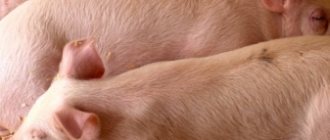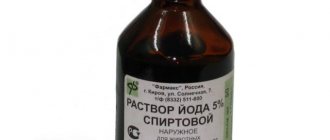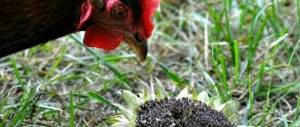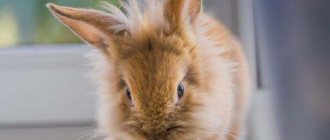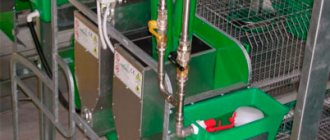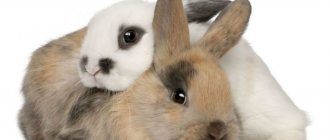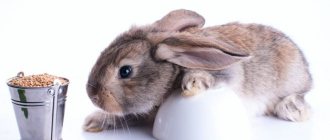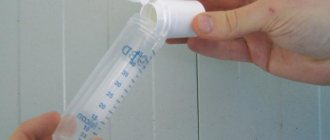Livestock » Rabbits
0
3723
Article rating
Kira Stoletova
Rabbits are rightfully considered real water drinkers: at one time, a decorative eared dog can drink as much as a medium-sized dog, so the animal’s water bowl should always be full. When asked what to feed rabbits with, any breeder will immediately answer: plain water. However, sometimes furbabies need extra vitamins and minerals that they cannot get from food.
What to feed rabbits
In order to replenish the salt balance in the body, pets are often given preventive drinking. It should also be remembered that during the warm period, the furry animal receives a lot of moisture from greens and fresh vegetables and does not need water so much. During the frosty months, the animal eats mainly roughage and concentrated feed, therefore, the daily water intake should be higher. What should be added to water to prevent diseases, how to feed rabbits in winter and during pregnancy?
What can you feed rabbits and how to do it
Farms often breed rabbits. To insure against problems in the form of low birth rates and insufficient weight of individual individuals, you need to add water to the drinking bowl on time and in a certain amount. In addition to these conditions, the temperature regime must be observed. To thrive, you need to carefully monitor your diet. Let's look at the best way to feed rabbits.
What can you feed rabbits and how to do it
Do you need water?
Often new farmers believe that rabbits do not need water. This is true if they are free and can take care of themselves.
At home, it is better to always give your animals clean water. If it is not there, pets will lose weight and refuse food. Thirst torments the newborn rabbits so much that if you don’t bring them a drink in time, she will begin to eat the offspring.
A nursing and pregnant rabbit drinks 2 liters in 1 day.
In the heat they feel unwell and may even die of thirst. To calculate how much liquid there should be, you need to consider several factors:
When using ready-made dry products, you need to leave even more water.
Water standards for pregnant rabbits and rabbits
During pregnancy, females experience increased thirst. This is due to the saturation of the rabbits and the creation of amniotic fluid. The daily norm of the expectant mother at this time reaches a liter. During this period, the female must be closely monitored: after giving birth, she needs a lot of water, otherwise she will begin to eat her own offspring to compensate for the lack of fluid.
Daily water requirement
A nursing rabbit consumes at least 2 liters of water per day. In addition, in large farms, females are very often used for mating on the second day after giving birth, therefore, a nursing and pregnant mother needs a lot of fluid to cope with the load.
Young animals need at least two liters per day per kilogram of concentrated feed.
What should the liquid be like?
There is no need to introduce additional liquids into the rabbits' diet. It is enough to stand with tap water that does not contain chlorine.
Water is an integral part of the animal's body. Rabbits tolerate a lack of water much more difficult than starvation.
You cannot drink from a river, stream or lake. Dirty slurry can infect an animal, even to the point of death. It is optimal to buy bottled products. Sometimes farmers boil water before using it.
Do not give hot or cold. Rabbits cannot stand this and may even refuse to eat.
Some people believe that there is no need to water rabbits in winter, because they will bite ice or chew snow, but this is likely to cause them to catch a cold.
In addition to a cold, there are several other factors that affect appetite:
- Dirty.
- Lots of juicy vegetables.
- Inconvenient or damaged drinking bowl.
- Violation of the salt balance of the body.
To normalize it, you should give the rabbits slightly salted water. This should be done especially often in winter. But you cannot give cubic salt like cows. This composition does not contain the necessary microelements.
Types of drinking bowls
All types of standard drinkers are suitable for rabbits:
In nipple drinkers, the design may jam. It is better to be extremely careful when using such a mechanism. Water retention causes unpleasant consequences. The tip of the nipple must be periodically lubricated with alcohol for disinfection purposes.
The ball of the nipple drinker must be constantly checked. In some cases it gets stuck and the rabbit cannot drink
Semi-automatic ones include those in which water is supplied gradually by itself. The design is easy to make. Turn the sufficiently filled bottle or jar upside down and place it in a cup with high edges and a large diameter.
In open ones, you need to pay special attention to cleanliness; no one will drink water full of garbage. In winter they are inconvenient because they freeze quickly.
Making drinking bowls
When owners keep several rabbits, then, of course, drinking bowls for them can be bought in the store. But arranging drinking bowls in a large farm will require a lot of expenses. Therefore, it is better to make the equipment yourself. To do this, you need to stock up on the materials necessary for a particular type of drinker and understand the technique of making the tank.
Vacuum models
To make a vacuum sippy cup, you will need tools such as a drill, a knife, and needle-nose pliers. The materials you will have to take are boards, screws and wire thread. A bottle for a vacuum drinker will need to be reliable so that water pours out of it in an even stream. As for the color of the plastic, a dark bottle is better suited for such purposes, since water “blooms” quickly in a light container.
The sequence of making a sippy cup is as follows:
- A drinking tray is attached to the inside of the cage at a height of 8-10 cm from the floor;
- From the outside of the cage, a bottle is tipped over the tray, which is attached to the cage rods using clamps made of wire;
- When attaching the bottle, make sure that its neck does not touch the bottom of the vessel, as this will prevent water from flowing.
A vacuum sippy cup is easy to make, and it is also very convenient for the rabbits themselves. This homemade device will provide your pets with water for a long time.
Drinking bowl from a plastic bottle
Such a sample of a drinking bowl for rabbits can be made in a matter of minutes without extra costs. To do this, take a 1.5 liter plastic bottle, cut a hole in it according to the size of the rabbit’s head, and secure the finished drinker to the bars of the cage with a strong wire thread. The animals will have constant access to water. This drinking bowl is easy to clean, however, it is not durable. Often rabbits chew it, and replacement may be needed within a few weeks. This is not so difficult, because plastic bottles are available to everyone.
Nipple sippy cups
Making a nipple drinker is quite simple. It won’t take much time, you just need to have a plastic bottle, a hose, nipple balls, electrical tape and sealant on hand. Such a drinking bowl is made as follows:
- A hole is made in the bottle cap with a screwdriver or a hot skewer;
- A plastic tube (hose) is threaded into the lid; if necessary, it is wrapped with electrical tape to ensure a tight connection;
- The connection point is lubricated with a sealant to prevent water leakage;
- A nipple spout is inserted into the hose (it can be purchased or made from the body of a pen) and is also secured with silicone sealant;
- A sippy cup is attached to the outside, and the hose is threaded inside.
Disease Prevention
To reduce the mortality rate of small animals, you need to give them medications added to the water after mandatory consultation with a veterinarian.
- Gamavit. Restores immunity.
- Solikoks. Antibiotic to fight coccidiosis and other diseases.
- Baycox. A similar remedy for the treatment and prevention of liver and stomach ailments.
- Iodine. It is recommended to give regularly, without exceeding the dose recommended by a specialist.
There are many other equally effective drugs. Specifics of use and dosage can be clarified at a veterinary pharmacy.
Treatment of diseases
Changing the components of the diet can cause intestinal colic in a rabbit, and, as a result, diarrhea.
To stop dehydration of the body, you can use a decoction of chamomile or a pale pink solution of potassium permanganate.
- Prepare the selected liquid.
- Draw into a rubber enema or syringe.
- Holding the animal tightly, pour it into its cheek.
Some of the medicine will spill, but the rest will go as intended. To be sure, it is better to repeat the procedure. It does not need to be done more than 2 times a week.
Do rabbits need to be given water?
Some breeders mistakenly think that rabbits do not need to be watered. Since the greens and grass are lush, the need for drinking disappears. In nature, rabbits have virtually no need for additional fluid. They choose the right food for themselves and feel how much and what they need.
Read also: How and how to feed baby rabbits without a rabbit
Animals that live in captivity are completely dependent on their owner. They can only eat the food that is put in the feeder. Accordingly, the health and proper development of their pets depends on the breeder. You cannot be 100% sure that your animals are not thirsty. Therefore, drinking water is provided daily!
If your animal is lethargic, sleeps a lot, eats poorly, and does not gain weight, then it is quite possible that its water balance is disturbed. Let's drink more. Do not forget to water the pregnant and lactating female more often. There should always be water in her cage! If the female wants to drink, but there is no liquid, then she can kill her cubs.
The rabbit does not drink: reasons and solutions
Usually, eared animals themselves know how much liquid they need per day, and actively demand water when there is a shortage. If a rabbit does not drink, there may be several reasons:
- dirty water;
- poor drinking bowl design;
- a large amount of greens and vegetables in complementary foods.
It is also important to pay attention to the pet’s general behavior: if, in addition to a reluctance to drink, the rabbit exhibits apathy and poor appetite, then these are the first signs of illness.
Reasons why a rabbit doesn't drink
The water also needs to be checked for chlorine levels: animals sense this component acutely and may refuse to drink. The drinking bowl also plays an important role: the liquid in it must be easily accessible, the rabbit should not pull it out with force.
If there are no obvious reasons, the animal consumes too little water, you need to add some special salts. First of all, this will help restore the salt balance in the body, and besides, the rabbit drinks this water more often. Sometimes farmers add a little sugar to the water for the same purpose. This component is neutral, but makes the fluffy come to the drinking bowl more often. In winter, the eared can drink more than in summer. This should be taken into account and do not forget to check the drinking bowl on time.
What kind of water is suitable for rabbits?
It is better not to use water from rivers, dirty wells or lakes. Tap water is also not suitable. Unfortunately, it may contain E. coli and other dangerous infections. The best option is water that has been passed through a filter.
The second place is occupied by ordinary, but well-settled water. You can also give the animals boiled water. Of course, you can purchase special bottled water, but not all breeders have the financial ability and desire to spend extra money on their farm.
Do not give very cold or hot drinks. The optimal temperature is from 18 to 25 degrees Celsius. What to do in winter when the water freezes very quickly? Try giving your rabbits warm water at lunch. As soon as you drink it, remove the sippy cup. Another option is snow or ice. Choose only pure snow-white snow or transparent, clean ice.
How to water rabbits
It is best to feed rabbits from special sippy cups. Today, specialty stores provide a huge selection of options. Your task is to firmly screw such a sippy cup to the wall of the cage. It must be securely fixed! The best option is a drip cup. It is ideal for all breeds without exception.
The water in it needs to be changed every day to protect animals from infections. Wash the sippy cup with boiling water at least twice a week or sterilize it. The spout of the sippy cup must be wiped with alcohol.
Animals, like people, need water. Always make sure your pets have the correct diet and water balance!
The importance of water for rabbits
Seventy percent of a rabbit's body consists of liquid, which means that water is vital for the long-eared. This is the main fluid they need. When water is supplied in the required quantities, the processes of digestion and assimilation of food occur as expected, all nutrients are absorbed into the blood without difficulty.
In addition, water affects the timely emptying of the animal and maintains its body temperature at the desired level.
Consequences of lack of fluid
If your pet, for any reason, starts not getting enough liquid to drink, digestive upset is guaranteed. This will be followed by kidney problems, blood thickening, hair loss, etc.
By the way, one of the reasons for such an unpleasant phenomenon as a female eating her newborn offspring is the lack of drink near her. It is believed that in this way the “mother” saves the children from supposed death from thirst, since she herself will not begin lactation if she does not drink a lot of water. It is especially important to give the rabbit water immediately after giving birth, when she loses a very large amount of fluid.
Rules for rabbit water consumption
The frequency with which you need to water your rabbit is twice a day, morning and evening, if there is no automatic waterer. However, in the summer, when the heat is unbearable, you can safely increase this amount to three times a day, for example, at lunchtime. In the summer, it is correct to pour cool (but not cold) water into the drinking bowls, approximately 18-20°C.
What kind of water do rabbits need?
Water for fluffies is taken from clean sources (from a tap, well). Rivers, ponds and other bodies of water are not suitable for this purpose. Leave the water for a day or filter it. No need to boil. Before “serving” you can even warm it up a little, but not much, room temperature will be quite enough.
Read also: What grass to feed rabbits?
Animals are given a drink before feeding is given out. If you are going to feed grass, then water before or immediately after feeding can cause bloating in the stomach.
How to determine an eared cat's need for water
To understand how much fluid an animal needs, you need to correlate the following factors with each other:
- pet's age;
- his state of health;
- breed;
- season;
- ambient air temperature;
- frequency and dose of dry food consumption.
For example, young animals and females before and after giving birth should drink much more than older rabbits. They can drink a liter, or even more than two and a half liters, per day.
When a rabbit's diet consists mainly of dry food, the amount of water must be increased: one kilogram of dry food equals 1-2 liters of liquid. If you introduce succulent food into the menu for an animal: greens, root vegetables, usually this happens in the fall, then you need to give them less to drink. This will prevent your little ear from getting an upset stomach.
In addition, each breed may drink more or less than others. If you monitor the constant availability of water in the drinking bowls and constantly change it to fresh and clean water, then the animals themselves will figure out how much they need to drink.
It’s another matter if, in addition to ignoring fluids, the eared one refuses to eat, is little mobile or does not move at all. These are clear signs of the disease.
Drinkers for rabbits
You can use the most common containers as a drinking bowl for a rabbit: bowls, shallow plates, etc. True, their inconvenience is that various types of garbage can easily get there, incl. wool, food, cat feces, and water become unfit for consumption. Also, animals, moving around the cage, turn over light containers. As a result, they have nothing to drink, their bedding becomes wet, which causes paw disease.
So what should you use to feed rabbits so that it is convenient for both the animals and the owners? The option with special drinkers works great. They are made independently or purchased ready-made designs. There are open type and nipple drinkers. The latter are bottles attached to a cage and are considered more hygienic. The animal presses on the nipple and gets water when it needs it.
Should Eared Ears be given milk?
Everyone knows that little rabbits drink milk; they need it for normal development. But is it necessary to continue giving it to adults? Due to the fact that the digestive system of rabbits is an extremely fragile system, it is not necessary to feed them milk, as well as other milk derivatives.
How and how to treat diarrhea at home
Treatment of diarrhea in rabbits should be started immediately. To do this, the sick animal should be provided with optimal comfort and conditions for rapid treatment. The cage with the pet is installed in a warm place protected from drafts. All unnecessary items are removed from it, and instead of bedding, a clean piece of fabric is placed, which is changed as it gets dirty.
Important! Infusions and decoctions must be fresh, since a day after preparation they become practically useless for the body
Pharmacy drugs
Among the traditional drugs for the treatment of diarrhea in fur-bearing animals, the most often used are:
- "Linex" - the product has a beneficial effect on the intestinal microflora, which normalizes the state of digestion in almost any poisoning. Give the drug twice, morning and evening, half a capsule. Therapy is continued until traces of the disorder are completely eliminated.
- "Baytril" is a powerful antibiotic used for any disorders of the body caused by infectious damage to organs and tissues. It is injected subcutaneously into the withers area at a dose of 0.1 ml/1 kg of animal weight, 3 times a day, until the symptoms of infection are eliminated.
- Ringer's solution - helps prevent dehydration. It is administered intramuscularly, 2–4 times a day, 10–12 ml/1 kg of weight throughout the entire therapy.
- "Furazolidone" is effective for diarrhea caused by paratyphoid fever. Give it once a day, at a rate of 30 mg/1 kg of rabbit weight, for 7 days.
- "Espumizan" is most appropriate for diarrhea accompanied by severe gas formation in the intestines. It is given orally, 1 ml/1 kg of animal weight, 1 time per day, throughout the entire therapy.
After the main course of treatment has been successfully completed, sick rabbits are given restorative therapy. Despite defeating the main causes of diarrhea, the animal’s body remains weakened for 1–2 weeks. To maintain it, the drug Baycox is most often used. The product helps protect the rabbit from other pathogenic microflora. An aqueous solution is prepared from it (1 ml/1 l of water), which completely replaces drinking water. The duration of such therapy is 2–5 days.
Learn about treating coccidiosis in rabbits.
Traditional methods of treatment
Unfortunately, most rabbit breeders have no idea what to do or what to feed sick rabbits if there is no traditional medicine at hand. You can effectively overcome diarrhea with the help of folk remedies.
The most effective among them are:
- Chamomile decoction - prepare it from a mixture of 250 ml of water and 1 tbsp. l. chamomile, which is infused in a water bath for 30 minutes. The resulting liquid is cooled and filtered. The decoction is administered to sick animals orally, 3 times a day, at the rate of 1 tbsp. l. decoction per 0.5 ml of clean water. The duration of therapy is 7–10 days.
- Oak bark decoction - 1 tbsp. l. oak bark is infused in a water bath for 30 minutes in 250 ml of water. The solution is cooled, filtered and given to sick animals 1 tbsp. l. 3 times a day. The duration of such therapy is about 10 days.
- Potentilla infusion - 1 tbsp. l. dry herbs are infused in 200 ml of boiling water until cool. The resulting liquid is filtered and given to the animals 1 tbsp. l. 3 times a day for 10–13 days.
How to water rabbits in winter
Special attention should be paid to the rules for supplying water to rabbits in winter. The main difficulty is that when the thermometer drops lower and lower, the water in the drinking bowl becomes colder, or even freezes quickly.
The problem of how to give water to rabbits in winter can be solved if it is possible to heat the water in automatic mode. Otherwise, it will have to be heated a couple of times a day to 30-35°C so that the pets do not have to drink ice water; this is simply unacceptable.
Snow instead of water?
There is a trick to give rabbits snow instead of water in winter. Ice is also used. Some rabbit breeders explain this approach by the fact that in natural conditions, eared rabbits survive during cold periods, because no one pours or heats water especially for them.
However, this method should be used only as a last resort when there are no other options. In this case, the snow or ice must be clean.
But remember that eating snow threatens a significant decrease in the animal’s body temperature, and, accordingly, various colds. Also, a frozen rabbit will eat many times more. It turns out that instead of spending on an electric drinker or heating water on your own, the money will be spent on additional purchases of feed or, in the worst case, medicines.
How to prepare a queen cell
In the cold winter, pregnant females and small ones need appropriate care. When the outside air temperature is below 25 degrees, the female rabbit can give birth. Under these conditions, babies survive only when the queen cell is well insulated and properly equipped. Before breeding, the rabbit breeder must thoroughly insulate the facade part, which consists of a mesh and the mesh itself.
Covering the mother plant with garden agro-cloth or polystyrene foam will help protect the mother plant from frost. The cracks need to be sealed perfectly. This is necessary so that the wind does not get into the middle of the queen cell. The mesh floor in the queen cell must be covered with a sheet of oranite of the required size or thick cardboard. After this, cover it with bedding. If you prepare the queen cell located outside in this way, the breeding will take place without any incidents.
In winter, a female can bring her offspring, even if the air temperature outside is 20 degrees below zero. A prerequisite for normal breeding in winter is proper ventilation and impeccable cleanliness in the queen cell. If all these conditions are not met, the female will begin to take poor care of her babies. And this leads to a lag in development and growth, and possibly even to the death of the rabbits.
How to water rabbits
Since a significant part of a rabbit's diet consists of green food and juicy root vegetables, the question often arises - what is the animal's need for water and how to water it correctly? The opinion that animals obtain all the moisture necessary for the body from juicy food is incorrect, especially if there is a lot of dry food on the rabbit menu. Let's figure out how and what to feed rabbits in order to create optimal living conditions for them.
What to feed rabbits
Why does a rabbit drink a lot of water or practically none?
Each individual rabbit's fluid intake may vary from day to day. That is, if today an adult animal drinks 2 liters, then tomorrow this value may drop to 1 liter or even more. Why do long-eared animals need water? We have already figured it out; all that remains is to find out the reasons for refusing it.
The most typical include the following:
- dirt and bad odor of liquid;
- the complex design of the drinking bowl does not allow the animals to easily get what they want;
- a large amount of succulent and green food in the diet;
- pet illness, especially if additional symptoms include apathy and refusal to eat.
To change the situation, it is important to carefully consider the possibility of each cause and, if necessary, replace the water, change the water bottle, or call the veterinarian
The role of water in the body of rabbits
An animal's body is seventy percent liquid. Water plays a significant role in such important life processes:
- digestion of food;
- absorption of nutrients;
- selection of metabolic products;
- maintaining body temperature.
Read also: Black-fire rabbits: how to care for and what to feed at home
Lack of fluid results in indigestion, kidney disease, and blood disorders for rabbits. Without drinking enough water, female rabbits can eat newborn rabbits. To avoid such cases, it is necessary to know what determines the need of animals for water.
Rabbits' water needs
So, the amount of liquid required is determined:
- the share of dry food in the rabbits’ diet;
- time of year and air temperature;
- age, breed and physiological state of the animal.
On average, it is enough to give water to rabbits twice a day - in the morning and evening. On hot summer days, the drink can be given three times - in the morning, in the evening and at noon. Before feeding your rabbits water, filter it or let it sit for 24 hours.
The drink should not be cold - it can be slightly warmed up to about room temperature. You cannot take water from open bodies of water (lakes, rivers, ponds). It is better to take it from a clean source, a well, or even from a tap (subject to filtration).
In winter, melted snow can be used as a source of water. Remember that young rabbits need to be watered more than older ones. Also, pregnant and lactating females need more abundant watering (from a liter to two and a half liters per day).
If dry food predominates in the rabbits' diet, then they will need more water (from a liter to two liters of water per kilogram of dry food). In the fall, when lush greens and root vegetables are abundant, the amount of liquid must be reduced, otherwise the rabbits may experience digestive upset.
When should you restrict water?
Water restriction is used in rare specific cases. For example, in acute mastitis, when the female accumulates excess milk in her nipples, which leads to their inflammation. This happens when the young rabbits suddenly die or are partially deposited in other nests (cuckooing or nest leveling). Also, when feeding rabbits, they are first given half the daily norm of water with a dissolved drug. After the water has been completely drunk, the supply is resumed in full. But if a rabbit begins to have digestive problems and is clearly diarrhea, then the amount of water should not be limited. Otherwise, dehydration of the entire body will occur. On the contrary, monitor its uninterrupted supply. Although the diet is changing towards dry food until the situation improves.
Water with additives
For prevention, you can add a few drops of iodine to the water of young rabbits that have just been separated from their mother. Young animals need to be given water with iodine for two weeks. This prevents animals from getting sick and falling.
It is also good for prevention to drink adults with water and iodine every six months for two weeks. Instead of iodine, a slightly pink solution of potassium permanganate is sometimes used as an additive.
Some rabbit breeders add cow's milk to the water for rabbits during lactation. Opinions about this supplement are mixed: some believe that water with milk increases lactation, while others have a negative attitude towards drinking it because of the risk of digestive upset in animals. It is also recommended that instead of cow's milk to feed rabbits, buy milk from other animals at the pet store, which is closer in composition to rabbit milk.
Is it possible to give a rabbit milk?
Little rabbits do drink their mother's milk, but this does not mean that adults can also be given this product. With age, the stomach of animals is rebuilt, and enzymes capable of breaking down animal protein and lactose disappear.
This means that they will not be able to digest normally, and the eared one will suffer from bloating and constant distress.
In the event of the death of a female rabbit, it is allowed to use diluted cow's milk to feed the offspring, and many rabbits, even after three weeks of age, can still safely digest this product for some time.
Some farmers add milk to the water of nursing rabbits to increase the amount of milk produced in her body.
Opinions on this matter are still ambiguous: some rabbit breeders talk about the benefits of such a drink, while others advise not to take risks, so as not to provoke an upset stomach in the new mother.
